Module bfm
This document contains technical documentation for the bfm module.
To browse the source code, visit the repository on GitHub.
This module contains a large set of Bus Functional Model (BFM) components for efficient VHDL simulation. These BFMs are used to send stimuli or check data in your testbench. Supports AXI, AXI-Lite and AXI-Stream protocols.
axi_bfm_pkg.vhd
Types and functions for the AXI BFMs.
axi_lite_bfm_pkg.vhd
Types and functions for the custom AXI-Lite BFM in hdl-modules (axi_lite_master_bfm.vhd). It is only used by this BFM, not the other AXI-Lite BFMs which are wrappers around VUnit VCs.
Warning
While this file and this eco-system is stable and usable, it is in a state of development. Expect API changes in the future.
axi_lite_master.vhd

Wrapper around VUnit axi_lite_master verification component (VC).
Uses convenient record types for the AXI-Lite signals.
Performs protocol checking on the R and B channels to
verify that the downstream AXI-Lite slave is performing everything correctly.
The instantiated verification component will create AXI-Lite read/write transactions
based on VUnit VC calls, such as read_bus.
If this BFM is used for a register bus, the convenience methods in
register_operations_pkg.vhd can be useful.
Note that the default value for bus_handle is the same as the default bus handle for the
procedures in register_operations_pkg.vhd.
Note
This entity is dependent on VHDL components from VUnit version 5.0.0 or greater, which is currently in a pre-release state. See Dependencies for more information.
axi_lite_master_bfm.vhd
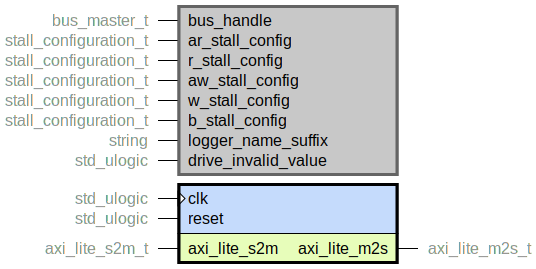
Bus Functional Model (BFM) to read/write/check values on an AXI-Lite bus. This BFM is a custom implementation, and an alternative to axi_lite_master.vhd, which is a wrapper around a VUnit VC.
Warning
While this file and this eco-system is stable and usable, it is in a state of development. Expect API changes in the future.
Usage
This BFM operates very much like other VUnit verification components using the “bus master”
eco-system.
Currently there are some subtle differences, which could probably be unified with VUnit.
But for now, the recommended way to use this BFM is with the
check_bfm, check_await_bfm, write_bfm, and write_await_bfm procedures
in axi_lite_bfm_pkg.vhd.
See e.g. the file tb_axi_lite_register_file.vhd for a usage example.
Randomization
This BFM will inject random handshake stall/jitter, for good verification coverage.
Modify the *_stall_config generics to get your desired behavior.
The random seed is provided by a VUnit mechanism
(see the “seed” portion of this document).
Use the --seed command line argument if you need to set a static seed.
Differences compared to VUnit VC
Compared to the VUnit Verification Components (VC) that is wrapped in axi_lite_master.vhd, this BFM:
Supports synchronous reset.
Unlike VUnit bus master eco-system, the register
checkprocedures for this BFM performs the check in the BFM, not the procedure call. This means that check calls are not blocking, and multiple checks (or other operations) can be queued up and executed back-to-back.Fully randomized stall of
RREADYandBREADY.The signals can be ‘1’ even when it is not supposed to receive a reply, and fall to ‘0’ even when it is expecting a reply.
Independent randomized stall of
AWandWchannels.WVALIDcan arrive beforeAWVALID. Potentially multipleWtransactions before the firstAWVALID.Potentially multiple
AWtransactions before the firstWVALID.
Supports transactions without bubble cycles on all the channels.
Limitations
No strobe (byte enable) support.
Does not, at this point, support the regular e.g.
read_buscalls.
All of this could be supported in the future.
axi_lite_read_slave.vhd

Wrapper around VUnit axi_read_slave verification component.
Uses convenient record types for the AXI-Lite signals.
Performs protocol checking to verify that the upstream AXI-Lite master is performing
everything correctly.
The instantiated verification component will process the incoming AXI-Lite operations and apply them to the VUnit memory model.
axi_lite_slave.vhd

Wrapper around VUnit axi_read_slave and axi_write_slave verification components.
Uses convenient record types for the AXI-Lite signals.
The instantiated verification components will process the incoming AXI-Lite operations and apply them to the VUnit memory model.
This entity instantiates axi_lite_read_slave.vhd and/or axi_lite_write_slave.vhd based on what generics are provided. See those BFMs for more details.
axi_lite_write_slave.vhd

Wrapper around VUnit axi_write_slave verification component.
Uses convenient record types for the AXI-Lite signals.
Performs protocol checking to verify that the upstream AXI-Lite master is performing
everything correctly.
The instantiated verification component will process the incoming AXI-Lite operations and apply them to the VUnit memory model.
axi_master.vhd

Creates AXI read/write transactions by wrapping the VUnit axi_lite_master
verification component (VC).
Uses convenient record types for the AXI signals.
Performs protocol checking to verify that the downstream AXI slave is performing
everything correctly.
Note
This AXI BFM wraps an AXI-Lite verification component, meaning it can not be used to produce burst transactions. If you want to create burst transactions, with built-in checkers, see the axi_read_master.vhd and axi_write_master.vhd BFMs instead.
The AXI-Lite interface of the wrapped verification component is connected to the “full” AXI interface of this BFM. This wrapper is typically only used for register read/write operations on the chip top level, where the register bus is still AXI.
It is used by performing VUnit VC calls, such as read_bus,
or, preferably when operating on a register bus, by using the convenience methods
in register_operations_pkg.vhd.
Note
This entity is dependent on VHDL components from VUnit version 5.0.0 or greater, which is currently in a pre-release state. See Dependencies for more information.
axi_read_master.vhd
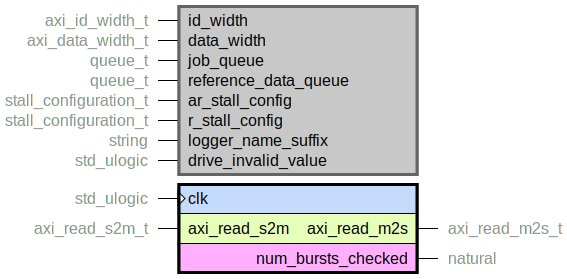
BFM that creates AXI read transactions and checkers based on a simple interface.
AR transactions will be created based on jobs (axi_master_bfm_job_t) that the user
pushes to the job_queue VUnit queue.
The data returned on the R channel will be checked against the
integer_array_t data
pushed by the user to the reference_data_queue.
The returned RID will be checked that it is the same as the corresponding ARID.
Randomization
This BFM will inject random handshake stall/jitter, for good verification coverage.
Modify the ar_stall_config and r_stall_config generics
to get your desired behavior.
The random seed is provided by a VUnit mechanism
(see the “seed” portion of this document).
Use the --seed command line argument if you need to set a static seed.
Protocol checking
This BFM will also perform AXI-Stream protocol checking on the R channels to verify that the
downstream AXI slave is performing everything correctly.
Warning
The RID check is based on the assumption that R transactions are returned in the same
order as AR transactions are sent.
Also the job address is assumed to be aligned with the bus data width.
Unaligned transaction length
The byte length of the transactions (as set in the job as well as by the length of the
reference_data arrays) does not need to be aligned with the data width of the bus.
If unaligned, the last AXI beat will not have all byte lanes checked against reference data.
axi_read_slave.vhd

Wrapper around VUnit axi_read_slave verification component.
Uses convenient record types for the AXI signals.
This BFM will also perform protocol to verify that the upstream AXI master is performing
everything correctly.
The instantiated verification component will process the incoming AXI operations and apply them to the VUnit memory model.
axi_slave.vhd
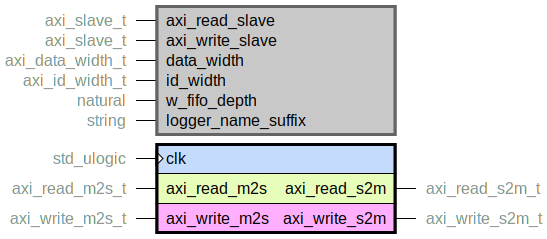
Wrapper around VUnit axi_read_slave and axi_write_slave verification components.
Uses convenient record types for the AXI signals.
The instantiated verification components will process the incoming AXI operations and apply them to the VUnit memory model.
This entity instantiates axi_read_slave.vhd and/or axi_write_slave.vhd based on what generics are provided. See those BFMs for more details.
axi_slave_bfm_pkg.vhd
Types and convenience methods for working with VUnit axi_slave_t.
Used by some BFMs.
axi_stream_master.vhd
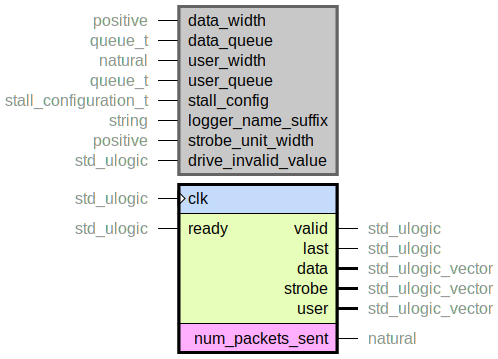
BFM for sending data on an AXI-Stream interface.
Data is pushed to the data_queue VUnit queue as a
VUnit integer_array.
Each element in the integer array should be an unsigned byte.
Little endian byte order is assumed.
Randomization
This BFM can inject random handshake stall/jitter, for good verification coverage.
Modify the stall_config generic to get your desired behavior.
The random seed is provided by a VUnit mechanism
(see the “seed” portion of this document).
Use the --seed command line argument if you need to set a static seed.
Unaligned packet length
The byte length of the packets (as indicated by the length of the data_queue arrays)
does not need to be aligned with the data_width of the bus.
If unaligned, the last data beat will not have all byte lanes set to valid
data and strobe.
User signalling
This BFM optionally supports sending auxiliary data on the user port also.
Enable by setting a non-zero user_width and a valid user_queue.
User data is pushed as a VUnit integer_array
just as for the regular data.
The length of packets must be the same as what is pushed to the data_queue.
axi_stream_slave.vhd
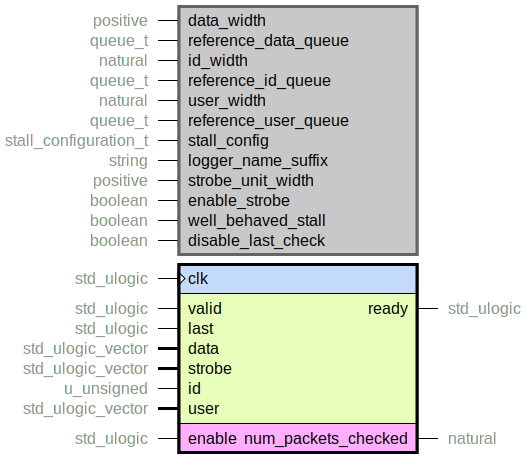
BFM for verifying data on an AXI-Stream interface.
Reference data is pushed to the reference_data_queue
VUnit queue as a
VUnit integer_array.
Each element in the integer array should be an unsigned byte.
Little endian byte order is assumed.
Randomization
This BFM can inject random handshake stall/jitter, for good verification coverage.
Modify the stall_config generic to get your desired behavior.
The random seed is provided by a VUnit mechanism
(see the “seed” portion of this document).
Use the --seed command line argument if you need to set a static seed.
Unaligned packet length
The byte length of the packets (as indicated by the length of the reference_data_queue
arrays) does not need to be aligned with the data width of the bus.
If unaligned, the last beat will not have all data byte lanes checked against reference data.
ID field check
An optional expected ID can be pushed as a natural to the reference_id_queue in order to
enable ID check of each beat.
User field check
Furthermore, and optional check of the user field can be enabled by setting the
user_width to a non-zero value and pushing reference data to the reference_user_queue.
Reference user data should be a VUnit integer_array just
as for the regular data.
axi_write_master.vhd
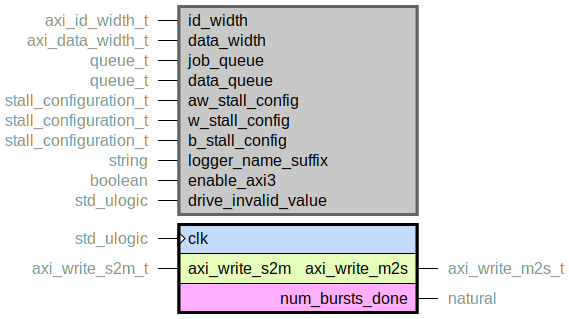
BFM that creates AXI write transactions and checkers based on a simple interface.
AW transactions will be created based on jobs (axi_master_bfm_job_t) that the user
pushes to the job_queue VUnit queue.
A W burst will be created based on the
integer_array_t data pushed by the user to
the data_queue.
Each AW transaction will result in a check that the eventually returned BID is correct.
This BFM will also perform protocol checking to verify that the downstream AXI slave is performing everything correctly.
Randomization
This BFM will inject random handshake stall/jitter, for good verification coverage.
Modify the aw_stall_config, w_stall_config and b_stall_config generics
to get your desired behavior.
The random seed is provided by a VUnit mechanism
(see the “seed” portion of this document).
Use the --seed command line argument if you need to set a static seed.
Unaligned transaction length
The byte length of the transactions (as set in the job as well as by the length of the
data_queue arrays) does not need to be aligned with the data width of the bus.
If unaligned, the last AXI beat will have a strobe that is not ‘1’ for all byte lanes.
The job address, however, is assumed to be aligned with bus data width.
Transaction order
Note that data can be pushed to data_queue before the corresponding job is pushed.
This data will be pushed to the AXI W channel straight away, possibly before the AW
transaction (unless in AXI3 mode).
axi_write_slave.vhd
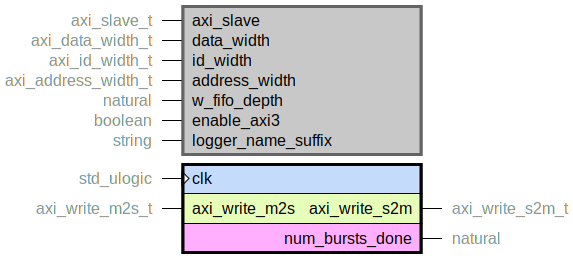
Wrapper around VUnit axi_write_slave verification component.
Uses convenient record types for the AXI signals.
This BFM will also perform protocol checking to verify that the upstream AXI master is
performing everything correctly.
The instantiated verification component will process the incoming AXI operations and apply them to the VUnit memory model.
bus_master_bfm_pkg.vhd
Types and convenience methods for working with VUnit bus_master_t.
Used by some BFMs.
handshake_master.vhd
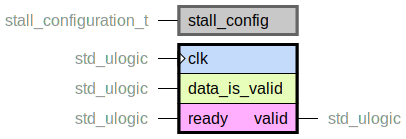
Toggle the valid signal based on probabilities set via generics.
This realizes a handshake master with jitter that is compliant with the AXI-Stream standard.
According to the standard, valid may be lowered only after a transaction.
This BFM can be more convenient to use than the axi_stream_master.vhd BFM in some cases. Specifically when the data is not an SLV, but instead a record. When using AXI-Stream BFMs we would need to have conversion functions to and from SLV. When using this BFM instead for the handshaking, the data can be handled as records in the testbench with no conversion necessary.
See the testbench tb_handshake_bfm for example usage.
Randomization
This BFM will inject random handshake stall/jitter, for good verification coverage.
Modify the stall_config generic to get your desired behavior.
The random seed is provided by a VUnit mechanism
(see the “seed” portion of this document).
Use the --seed command line argument if you need to set a static seed.
handshake_slave.vhd
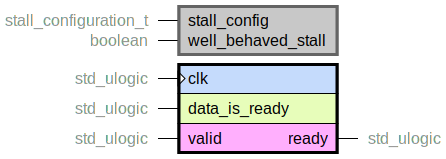
Toggle the ready signal based on probabilities set via generics.
This realizes a handshake slave with jitter that is compliant with the AXI-Stream standard.
According to the standard, ‘ready’ can be lowered at any time, not just after a transaction.
This BFM can be more convenient to use than the axi_stream_slave.vhd BFM in some cases. Specifically when the data is not an SLV, but instead a record. When using AXI-Stream BFMs we would need to have conversion functions to and from SLV. When using this BFM instead for the handshaking, the data can be handled as records in the testbench with no conversion necessary.
See the testbench ‘tb_handshake_bfm’ for example usage.
Randomization
This BFM will inject random handshake stall/jitter, for good verification coverage.
Modify the stall_config generic to get your desired behavior.
The random seed is provided by a VUnit mechanism
(see the “seed” portion of this document).
Use the --seed command line argument if you need to set a static seed.
integer_array_bfm_pkg.vhd
Convenience methods for working with VUnit integer_array_t.
Used by some BFMs.
memory_bfm_pkg.vhd
Types and convenience methods for working with VUnit memory_t.
Used by some BFMs.
queue_bfm_pkg.vhd
Types and convenience methods for working with VUnit queue_t.
Used by some BFMs.
stall_bfm_pkg.vhd
Types and methods for creating random stall in a testbench or BFM.